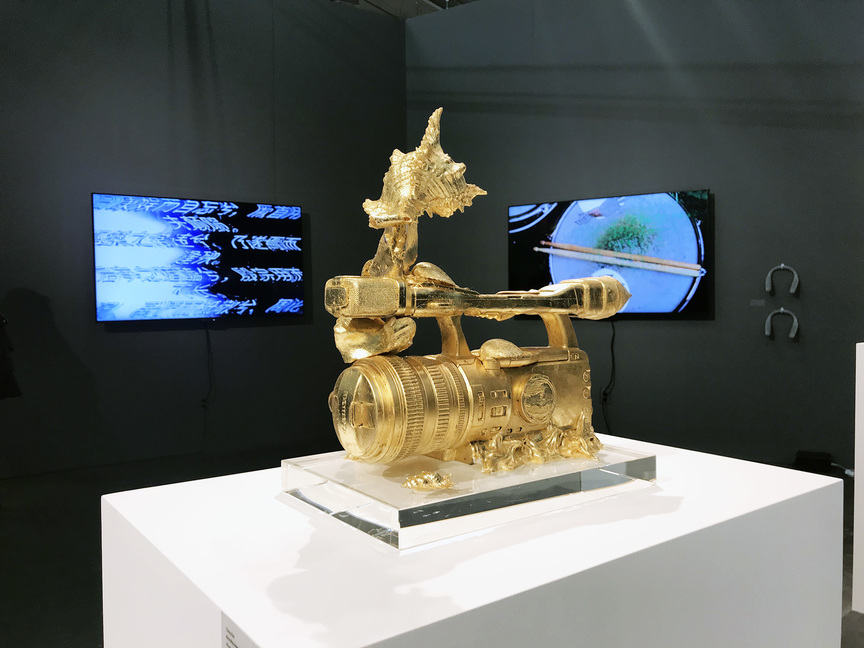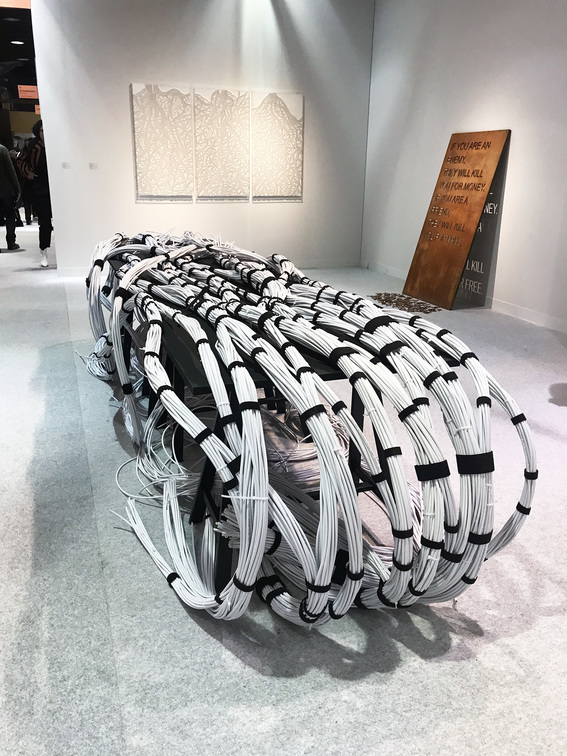
R
E
V N
E
X
T
Roundup From The Armory Show 2019
Installation view of TANADA KOJI’s wood sculptures and HORI KOSAI’s ink-and-paper drawings at the booth of Mizuma Art Gallery (Tokyo/Singapore). All photos by Mimi Wong for ArtAsiaPacific.
The Armory Show has come to be regarded as the art event in New York City. In 2019, the fair celebrated 25 years since its modest beginnings at the Gramercy Park Hotel. Days before its opening, however, the event was displaced from part of its venue—originally Pier 92 and Pier 94 on the Hudson River along Manhattan’s West Side—due to structural safety concerns with Pier 92. As a response, organizers cancelled the Armory’s sister fair, Volta, making room at Pier 90 to house one third of the Armory.
Despite the last-minute shift, the on-ground chatter reflected a sense of excitement. Thirty-three countries were represented between the 198 participating galleries—including 63 first-time exhibitors, such as Öktem & Aykut from Istanbul and ShanghArt Gallery, which has outposts in Shanghai, Beijing and Singapore. International exhibitors deployed various strategies to maximize their moment before the eyes of the anticipated 65,000-plus attendees. Gallery Hyundai from Seoul showcased a survey of Korean contemporary artists alongside attention-grabbing installations by Korean-American Nam June Paik. Nearby, Mizuma Art Gallery opted to focus on three of their Japanese artists. Representing Southeast Asia, Singapore’s STPI Gallery promoted pieces exemplifying print and papermaking techniques by Do Ho Suh and Kim Lim, among others.
For the fair’s Focus section, Lauren Haynes, curator of contemporary art at the Crystal Bridges Museum of American Art and a veteran of The Studio Museum in Harlem, emphasized the “interconnectedness of history.” Octogenarian Faith Ringgold maps the Black experience in America onto quilts at ACA Galleries’ booth. Mounir Fatmi, based in Paris and Tangier, utilizes antenna cables to underline a sense of disconnect in his works at Officine dell’Immagine. Filipina-American Stephanie Syjuco speaks to immigrant identities, proclaiming in big, block letters “I Am An American” across a black curtain on view at Ryan Lee. Syjuco lifted the words from a 1942 Dorothea Lange photograph documenting a storefront belonging to Japanese-Americans who were sent to internment camps. From the South Asian diaspora, Pakistani-born Abdullah MI Syed repurposes actual currencies, crafting a flying rug out of US dollars and a Mao suit out of renminbi.
Similar themes of displacement and unrest cropped up in the Platform projects situated throughout the fair. Siah Armajani’s “Seven Rooms of Hospitality” series (2016–17) features miniature, 3D-printed models, as well as one life-size construction, of bare-bones facilities for migrant workers, deportees, asylum seekers and refugees. In Quick Fix (2019), Super Taus, the alter-ego of the Russian artist Taus Makhacheva, invited participants to win trophies and rewrite their past by rolling dice in a game of chance. Meanwhile, Pascale Marthine Tayou amasses together and suspends from the ceiling a giant, multicolored heap of Plastic Bags (2019), symbolic of global consumerism, while portending environmental catastrophe.
These glimmers of urgent commentary served as thoughtful counterpoints to the otherwise commercial nature of the fair. In this way, The Armory Show strives to offer a bit of something for everyone.
Mimi Wong is a New York desk editor of ArtAsiaPacific.
The Armory Show is on view at Piers 90, 92 and 94 in New York, until March 10, 2019.
To read more of ArtAsiaPacific’s articles, visit our Digital Library.


















